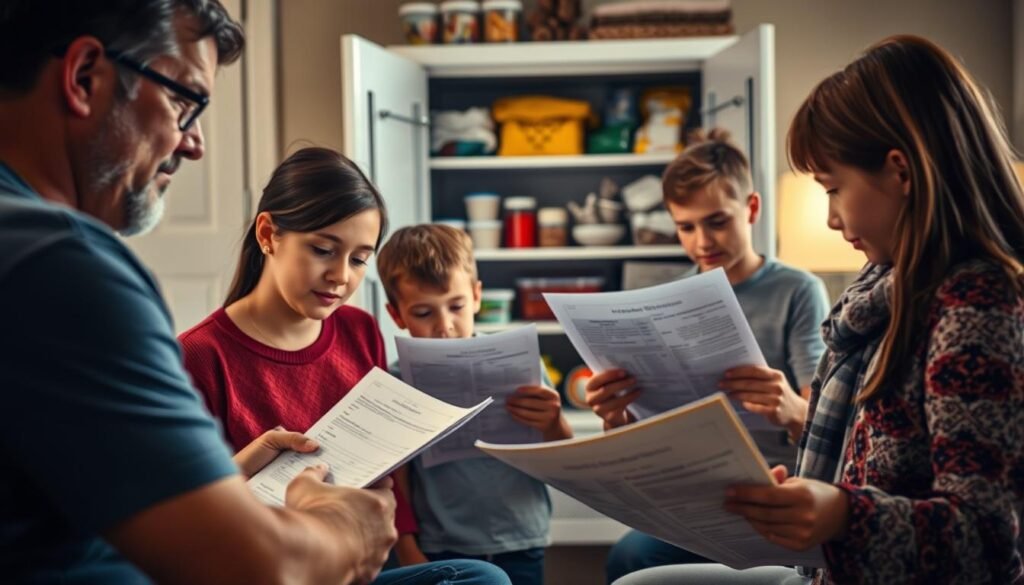Family Disaster Planning: Roles, Meeting Points, and Contact Sheets
Could one simple habit make the difference between chaos and calm during an emergency?
You can build a clear, usable plan that works under pressure without turning your life into a checklist. Start by naming two meeting spots: one just outside your home for fast events and one beyond the neighborhood if you cannot return.
Pick an out-of-area contact and save their details on phones and printed cards. Practice your emergency plan twice a year, drive primary and alternate routes, and include pet care and needs for older adults or people with disabilities.
This guide gives clear templates and checklists so every member knows what to do. Bookmark it for updated information and templates you can use today to boost your preparedness.
Key Takeaways
- Choose two meeting locations: immediate and out-of-neighborhood.
- Assign simple tasks so each family member knows their role.
- Pick an out-of-area contact and save details on phones and printed cards.
- Practice evacuation routes twice a year and plan alternates.
- Include pets, older adults, and people with disabilities in your plan.
Plan First: A Family-Centered, All-Hazards Approach
Begin with a quick risk check: which threats are common in your county, and which could affect your home, work, or school? This first step makes future choices clearer and faster when every minute counts.
Take an all-hazards view. Note common events like fires and floods, plus region-specific threats such as tornadoes, tsunamis, or volcanic activity. Decide whether each emergency calls for sheltering in place or evacuation.
Set your scope
Map where each person typically is during the day. That helps you plan reunification if an emergency strikes mid-commute or at school.
Use templates and checklists
Document actions, triggers, and destinations with free templates available in English and Spanish. Update the disaster plan when jobs, schools, or addresses change.
“Preparedness done ahead of time reduces stress and speeds recovery.”
| Response | When to use | Key trigger |
|---|---|---|
| Shelter in place | Winter storms, chemical release | Official shelter orders or hazardous air |
| Evacuate | Hurricane, wildfire near home | Evacuation notice or rising water/fire |
| Alternate action | Power loss, localized flood | Loss of utilities or blocked routes |
- Identify likely hazards in your area and match clear triggers to actions.
- Assign simple duties for each person and practice at least twice a year.
- Bookmark templates and return over time to keep the plan current with your community needs.
Define Family Roles and Responsibilities for Emergencies
List everyone in your household and mark specific needs first. Note mobility aids, meds, language preferences, and pet care. This makes assignments realistic and usable under stress.

Who does what
Start with a simple list of family members and assign duties by age and availability. Teens can check on younger children; trained adults handle utility shutoffs; travelers confirm status with your out-of-area contact.
Special needs and locations
Include older adults and people with disabilities. Add backup power for devices, extra meds, and accessible exit routes. Make sure schools, daycares, and campuses have your long-distance contact and emergency numbers.
Practice and keep access easy
Run home fire drills and evacuation walk-throughs twice a year. Time your exits, drive alternate routes, and grab your emergency kit each practice.
- Keep printed copies in wallets, backpacks, and glove boxes, plus a shared cloud folder for the latest version.
- Create quick-reference cards with essential task checklists so members can act fast.
- Set calendar reminders for plan refreshers and medication rotations.
“Thoughtful assignment and regular practice make your family disaster plan work when it matters.”
Family Disaster Planning: Roles, Meeting Points, and Contact Sheets
Pick a nearby assembly spot for fast exits and a distant place if you cannot return home. Decide these locations now so everyone knows where to go and how to confirm when it’s safe to return home.
Meeting places and shelter choices
Choose one place just outside your home for quick events like a fire. Pick a second meeting place beyond your neighborhood if an evacuation order prevents you from returning home.
Write clear triggers for shelter-in-place versus evacuation. For example, stay put for severe weather or some chemical releases. Leave for rising water, fire, or gas leaks.
Routes, gas, and transport
Map primary and alternate routes, save them on your phone and on paper. Practice routes twice a year with your kit.
If you drive, keep at least half a tank of gas. If you don’t, arrange rides with neighbors or friends and name a backup person to help reach shelters or the meeting place.
Contact cards and long-distance checks
Create wallet-sized cards with a local contact and an out-of-area contact. Agree to text first—texts often work when phone service is spotty.
Share those cards with schools and daycare providers so they can coordinate reunification quickly.
Supplies, documents, and pet care
Assemble a 3-day kit with water, shelf-stable food, first aid, and tools in a portable bag. Add extra supplies for infants, older adults, and pets.
Use a NOAA Weather Radio with battery backup for alerts. Store cash in a watertight container and keep vital records in waterproof, fireproof portable storage.
“Practice your plan, update contacts, and rehearse routes so decisions feel automatic under stress.”
Conclusion
,
Start small: keep copies of your plan where each person can grab them fast—wallets, backpacks, glove boxes, and at home.
You’ve built a practical emergency plan that fits your household with clear steps for children and other members. Update the list on a set time schedule and refresh supplies like water and meds.
Tell every person to contact others when safe and keep an out-of-area contact to reconnect if local service fails. Choose neighborhood and community spots in advance and make sure children know how to text for help.
Bookmark this page for refreshed templates and checklists. For a ready template you can use, view this short guide: emergency plan template.
FAQ
What should you include on a contact sheet?
Start with names, cell and work phone numbers, and email addresses for everyone who lives with you. Add an out-of-area contact, school and daycare numbers, your doctor, veterinarian, and utility companies. Note any medical needs, allergies, and medication details. Keep a paper copy in wallets and backpacks, and store a digital version in a secure cloud folder for quick access.
How do you pick meeting places for your household?
Choose a spot just outside your home for fast evacuation, such as a mailbox or front neighbor’s porch. Pick a second location outside your neighborhood like a library, community center, or a nearby park. Make sure every member knows both addresses and a route to get there on foot or by car.
When should you shelter in place versus evacuate?
Stay put for chemical spills, tornado warnings when a shelter is closer, or active shooter incidents unless an official order tells you to leave. Evacuate for floods, wildfires, hurricane evacuation orders, or if your home structure is unsafe. Check local emergency alerts, and have both a quick grab bag and a full evacuation kit ready.
How often should you practice emergency roles and routes?
Run short drills twice a year and review roles after major life changes like a new job, a move, or a new child. Practice escape routes from every level of your home, rehearse meeting at designated spots, and test communications like group texts and the out-of-area contact method.
What belongs in a 72-hour kit?
Pack water for three days (one gallon per person per day), nonperishable food, a battery-powered NOAA Weather Radio, flashlight, extra batteries, first-aid kit, copies of important documents in a waterproof bag, cash, and supplies for pets. Rotate food and batteries annually and update medications as needed.
How do you account for children, older adults, and people with disabilities?
Assign specific helpers and list individual needs on your contact sheet: medications, mobility aids, medical devices, and communication preferences. Arrange transportation options, backup caregivers, and include school release procedures. Keep copies of prescriptions and care plans with your emergency documents.
What are the best ways to communicate if phone networks are down?
Use group text messages sparingly—SMS often gets through when calls fail. Rely on an out-of-area contact who can relay information, and consider a battery-powered NOAA radio or a handheld GMRS/FRS radio for local communication. Prearrange check-in times so everyone knows when to expect updates.
How do you plan routes and transportation if you can’t drive?
Identify neighbors, friends, or public transit options who can help. Map at least two routes from home to your meeting spots and shelters, noting bridges and flood-prone roads to avoid. Keep your vehicle fueled when a storm is forecast, and maintain a list of taxi and rideshare options in case of emergency.
How should you store important documents for quick access?
Keep originals in a fireproof, waterproof safe at home and scan documents into an encrypted cloud service like Google Drive or Microsoft OneDrive. Carry photocopies of IDs, insurance cards, and a medical summary in a waterproof folder in your emergency kit.
How do you keep pets safe during an evacuation?
Prepare a pet go-bag with food, water, vaccination records, medications, a leash or carrier, and a recent photo. Identify pet-friendly shelters, hotels, and boarding facilities ahead of time, and list neighbors or friends who can care for your animals if you can’t return quickly.
What templates and checklists can help you document the plan?
Use FEMA’s family emergency plan templates, the American Red Cross checklists, or downloadable spreadsheets that cover contacts, meeting spots, evacuation routes, and supply lists. Customize templates for your household and review them every six months.
How do you designate clear duties by age and ability?
Assign tasks like shutting off utilities, retrieving emergency kits, or guiding pets based on each person’s strengths and mobility. Give children simple roles—grab a backpack, check on a sibling—and list who will assist older adults or those with limited mobility during drills and real events.


